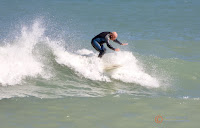 |
| La tour de lancement SLC-41 vue de la page. - Photo : rke |
[Cape Canaveral, December 15, 2019, rke, english below] – Eh, oui, me revoilà aux USA pour la quatrième fois cette année (mars, avril, juillet et décembre). Ce seront mes 31es et 32es lancements accrédités sur site. Mon but ? Finir 2019 en beauté pour marquer le 50e anniversaire d’Apollo 11 (21 juillet 1969) que j’ai vécu à Pleigne (JU), ado, à l’âge de 13 ans.
 |
En attendant... sur la plage.
par 27 degrés C. - Photo : rke
|
Cette semaine, je pourrai suivre trois lancements. D’abord, deux (accrédités) de Cap Canaveral : (SpaceX / Falcon 9 avec le satellite japonais JCSAT 18/Kacific 1) prévu demain lundi 16 décembre entre 7h10 et 8h38 locale (1h10 et 2h38 du matin en Suisse) et le plus important pour les Américains, Atlas 5 (CST–100 - Starliner) de Boeing prévu vendredi 20 décembre à 6h36 (locale), 12h36 (heure suisse) dont la capsule d’essai « non habitée » s’amarrera à la Station spatiale internationale (ISS), puis retournera sur Terre pour atterrir dans l’ouest des États-Unis après une croisière orbitale avant un vol d’essai en équipage de deux personnes. Un gros programme nous attend d’ailleurs cette semaine.
CHEOPS : à l’assaut des planètes habitables…
 |
Je ne suis pas à Kourou,
Mais à Cap Canaveral.
|
Et puis, je me sens un peu coupable de ne pas avoir choisir d’être à Kourou, en Guyane française, pour assister au lancement du satellite CHEOPS (Characterizing Exoplanet Satellite). Ce n’est pas une question de préférence de mission, mais d’agenda et de budget. Je ne peux pas, en effet être à la fois à Cap Canaveral et à Kourou en même temps puisque le décollage de la fusée russe Soyouz (la petite, mais la plus leste), décollera le mardi 17 décembre. Ce Soyouz transportera le premier satellite de surveillance radar COSMO-SkyMed de deuxième génération, ou CSG 1, pour l’agence spatiale italienne (ASI). Le satellite CHEOPS de l’Agence spatiale européenne (ESA) volera comme charge utile secondaire lors de la mission.
… par l’Uni de Berne et de Genève
Construit par Airbus Defense and Space en Espagne avec un instrument scientifique développé en Suisse – par l’Uni de Berne et de Genève – l’engin observera les transits de planètes autour d’autres étoiles pour mesurer leurs rayons. La fusée Soyouz 2–1b (Soyouz ST-B) utilisera un étage supérieur Fregat. Bon, comme la Guyane est en Amérique du Sud (dans le Nord), je suis quand même aux Amériques, d’où ce Blog, Press-Trip America. J’essaierai de vous commenter le lancement depuis ici, en Floride. Je ne suis donc pasaccrédité pour Kourou – bien que j’ai déjà assisté à deux lancements (TVSat en 1987 et Smart One en 2003), puisque je ne suis pas sur place. Alors, à bientôt.
America: 3 launches this week (Falcon 9, Soyuz and Atlas V)
 |
| The PAD 39B tower waits for SLS |
 | ||||||
|
This week, I will be able to follow three launches. First, two (accredited for me) from Cape Canaveral: SpaceX / Falcon 9 with the Japanese satellite JCSAT 18/Kacific 1 scheduled for tomorrow Monday, December 16 between 7:10 and 8:38 a.m. local (1:10 and 2:38 a.m. in Switzerland). Then, the most important for Americans, Boeing's Atlas 5 (CST-100 - Starliner) scheduled for Friday, December 20 at 6:36 a.m. (local), 12:36 p.m. (Swiss time) whose "uninhabited" test capsule will dock with the International Space Station (ISS), then return to Earth to land in the western United States after an orbital cruise and before a crowd test flight of two people. A big program is waiting for us this week.
CHEOPS: attacking the inhabitable planets....
 |
| Florida Today, December 15, 2019 |
 |
| Florida Today December 15, 2019 |
And then I feel a little guilty for not choosing to be in Kourou, French Guiana, to attend the launch of the CHEOPS (Characterizing Exoplanet Satellite) satellite. It is not a question of mission preference, but of agenda and budget. I cannot, indeed, be both in Cape Canaveral and Kourou at the same time since the takeoff of the Russian Soyuz rocket (the small but the most powerful), will take off on Tuesday 17 December. This Soyuz will carry the first second-generation COSMO-SkyMed radar surveillance satellite, or CSG 1, for the Italian Space Agency (ASI). The European Space Agency (ESA) CHEOPS satellite will fly as a secondary payload during the mission.
... by the University of Bern and Geneva
Built by Airbus Defense and Space in Spain with a scientific instrument developed in Switzerland – by the University of Bern and Geneva – the device will observe the transit of planets around other stars to measure their rays. The Soyuz 2-1b (Soyuz ST-B) rocket will use an upper Fregat stage. Well, since Guyana is in South America (in the North), I am still in the Americas, hence this blog, Press-Trip America. I'll try to comment on the launch from here in Florida. So I am not accredited for Kourou - although I have already attended two launches (TVSat in 1987 and Smart One in 2003), since I am not there. So, see you soon.



